SEO
Branded Search vs. Non-Branded Search: What’s the Difference?
Most SEO advice talks about optimizing for keywords that don’t mention your brand because that is how you can attract complete strangers to your business. But what about search queries that do mention your brand?
In other words, what about attracting people who are exactly searching for your business? Naturally, you can optimize your website for these kinds of queries too. In this guide, I’ll explain how to do that. We’ll cover the following:
The difference between branded and non-branded search is that a branded search contains your company, service, or product name, whereas a non-branded search doesn’t. This applies to both organic results and search ads.

Ranking for non-branded keywords allows you to attract people who are searching for products or services related to your business but may not necessarily know your brand. Hence, this is a great way to attract new customers.


Our blog article about our SEO checklist attracts searchers who don’t necessarily know our product. Data via Ahrefs’ Site Explorer.
We have an entire SEO course that focuses on optimizing for non-branded keywords. So in this article, we’re going to focus on SEO for branded search.
Ranking for branded keywords allows you to attract people who are specifically searching for information about your company.
They already know your brand but want to learn more about what you do. For example, they may be looking for reviews, comparisons with other brands, or specific information like technical data or media assets.
So with branded search, depending on the query’s intent, you’re targeting people who are:
- Close to buying from you – People may be looking up your brand specifically or searching for comparisons between you and your competition. You can address any objections, answer questions, or reassure them you are the right choice.
- Your current customers – Keeping your current customers informed is a straight path to keeping them happy.
- The press – The aim here is to be the #1 source of information.
- Brand fans and other people simply interested in what you do


Our landing page comparing our product to the competition attracts searchers who Google queries containing our brand name and “vs.” Data via Ahrefs’ Site Explorer.
There are basically four steps in this process. For the purpose of this guide, I’m going to use fintech company Revolut as an example (but this can be any company).
1. Find keywords related to your brand, company, or product
You need to create two lists of keywords to have a complete overview of your branded search landscape:
- Find keywords you rank for
- Find keywords you don’t rank for
One thing to keep in mind here is that everything we’re going to do in this guide is country-specific. You will need to repeat the process for every country whose keywords you want to rank for.
Find keywords you rank for
When you have an SEO tool like Ahrefs, finding keywords you rank for is a piece of cake. All you need to do is plug in your domain, go to the Organic keywords report, and type in words/phrases denoting your brand or products in the filters.


Tip: Don’t bother about misspellings of keywords. Google’s algorithms will likely take care of that with the correct spellings once you create content that ranks for those keywords.


Export that list of keywords and import it into a spreadsheet editor. I’ll be using Google Sheets.


And this concludes our first list. Now on to the next one.
Find keywords you don’t rank for
To create a list of keywords you don’t rank for, you need to combine and compare two lists: the list of branded keywords that you rank for (it’s what we just created) and a list of all branded keywords for your company. This is what we’ll do.
In your keyword tool—I’ll use Ahrefs’ Keywords Explorer—plug in the same branded keywords you used for the first list, choose the same country as before, and hit “Enter.”


Then go to the Matching terms report. You will get a list of all branded keywords.


Now we need to compare keywords you rank for with all keywords in order to get branded keywords you don’t rank for. So do the following:
- Export the list
- Import the list to a new sheet in the same spreadsheet as the first list
- Create an additional column in that newly imported list and name the column “Do we rank?”
- Insert this array formula into the first cell of that column:
=ArrayFormula(COUNTIF(Ranking!A2:A, B2:B)=1)
Where “Ranking” is the name of the sheet with keywords you rank for and the cell ranges are the column with your keywords.
This formula will automatically populate the entire column with “true” if you already rank for a given keyword and “false” if you don’t. Chances are you won’t get too many “falses” here, but the thing is you never know until you check.
This way, we’ve created the two keyword lists we need for this process. Now let’s see how we can use them.
2. Pick keywords worth targeting
Here’s how we’re going to categorize branded keywords worth targeting:
- Underperforming keywords – Because if you improve their rankings, you can get more traffic from the SERPs (search engine results pages)
- Pages with mismatched intent – Because mismatched search intent doesn’t give people what they came for
- Valuable new keywords – Because you can get more traffic by targeting new keywords
Underperforming keywords
Underperforming branded keywords are basically keywords that don’t rank #1. How far from #1? It depends on the search query and the competition.
If you think there’s a reasonable chance of a keyword ranking higher than the current position, you should try it. Generally speaking, for some queries, ranking in the top three is a success. But for those with really fierce competition (like search queries used for comparisons), ranking in the top 10 is a success.
And so open the first list, click on the “Current position” column, and sort from Z to A. Anything here that doesn’t rank #1 is your opportunity. Look at each keyword. If it’s something you can potentially create better content about, mark it.
Additionally, look at the “Volume” column to determine if that keyword gets any search demand in the country you’ve chosen.
Pages with mismatched intent
Now let’s choose keywords for the second category: mismatched intent. Since you’ve already gone through keywords that don’t rank #1, it’s time to take a closer look at those ranking #1. If you want to play on the safer side, you can extend your search to the top three or even the top 10.
Here’s an example of a page with mismatched search intent. People looking for Revolut’s logo probably want an official, high-quality image that’s downloadable. But Revolut doesn’t offer that on the pages that rank #1 for this query in the U.S.


So this keyword can be highlighted as “mismatched intent.”


Let’s move on to the last category: valuable new keywords.
New keywords
For this, we’re going to open the second sheet with all branded keywords. To show only those you don’t rank for in the chosen country, filter the “Do we rank?” column to only show “false” results:


Before we start to look at particular keywords, I suggest sorting them by search volume to get the most potentially valuable keywords first.
Now we can see if any of these keywords catch our eye. Here’s one: a comparison between Revolut and another fintech company:


3. Optimize existing content or create something new
Now we need to give search engines something they can rank. That means either optimizing content on existing pages or creating new content.
The list of keywords created in the previous step will tell us whether we need to do the first or the second. So:
- Keywords marked as “underperforming” or “mismatched intent” will need optimized content. For this, we’ve got you covered. Here’s a detailed guide on how to optimize your content for search engines.
- New keywords that you do not yet rank for will most likely need new content. I’m saying “likely” because you may need to reconsider that, sometimes, it’s better to include some topics on existing pages than have them be on separate pages. And here’s a complete guide on creating content designed to rank in search engines.
4. Add internal links
The last step in our process of optimizing for branded search is adding internal links.
Apart from helping users to navigate your website, internal links play an important role in SEO. First of all, search engines use them for discovering, (re)crawling, and indexing pages. Moreover, they help Google understand what your page is about. And last but not least, they pass link equity.
As this is quite a straightforward tip, I’ll keep it short. There are essentially three places on your website where you may want to add internal links to content targeting branded keywords:
- Site navigation – That means the top navigation and/or footer.
- Important pages – If you want your content to be discovered easily and quickly, add links to it on pages that get the most traffic (like the homepage) or on the most relevant pages (like features).
- Pages where you mention the keywords – For example, if Revolut mentions “buying stocks with Revolut” somewhere on its website, it can link to a blog post or a landing page dedicated to that topic.
Regarding the last point, you can streamline that process using Ahrefs (you can also do this for free using Ahrefs Webmaster Tools).
Go to Ahrefs’ Site Audit and open the Link opportunities report. In the advanced filter section, set a new filter with conditions: keyword context contains [your keyword or phrase]. This way, you can find relevant link opportunities for pages that haven’t even been published yet.


Recommended reading: Here’s Why You Should Prioritize Internal Linking in 2022
Final thoughts
The more a company grows, the more roads will lead to the company through branded search (81% of searches for SMBs vs. 58% for global brands).
But no matter the company size, SERPs seem to play the role of a company’s business card—people ask search engines all sorts of questions, and what they find becomes what they know. Thus, it’s good to own your branded queries.
Finally, if you decide to optimize your website for branded search, it’s important to know that the changes you make probably won’t take effect overnight. Remember, SEO takes time.
And if your SEO software comes with a rank tracker, use it to save yourself some time and effort—instead of manually checking your ranking progress, which can’t be done accurately anyway.
Next step: You can take optimizing for branded search even further by taking advantage of Google’s Knowledge Graph.
Got questions? Ping me on Twitter.
SEO
Measuring Content Impact Across The Customer Journey
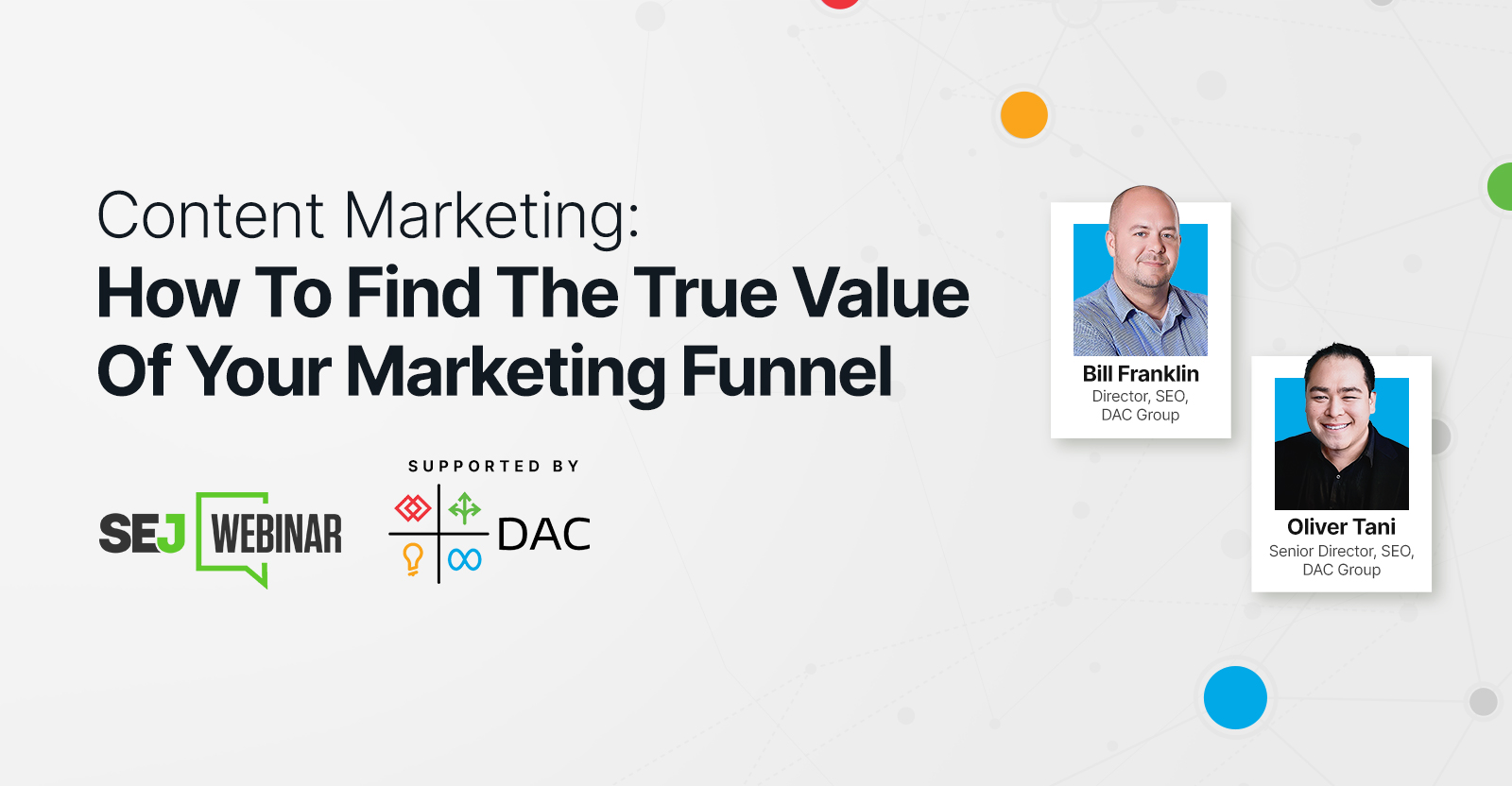
Understanding the impact of your content at every touchpoint of the customer journey is essential – but that’s easier said than done. From attracting potential leads to nurturing them into loyal customers, there are many touchpoints to look into.
So how do you identify and take advantage of these opportunities for growth?
Watch this on-demand webinar and learn a comprehensive approach for measuring the value of your content initiatives, so you can optimize resource allocation for maximum impact.
You’ll learn:
- Fresh methods for measuring your content’s impact.
- Fascinating insights using first-touch attribution, and how it differs from the usual last-touch perspective.
- Ways to persuade decision-makers to invest in more content by showcasing its value convincingly.
With Bill Franklin and Oliver Tani of DAC Group, we unravel the nuances of attribution modeling, emphasizing the significance of layering first-touch and last-touch attribution within your measurement strategy.
Check out these insights to help you craft compelling content tailored to each stage, using an approach rooted in first-hand experience to ensure your content resonates.
Whether you’re a seasoned marketer or new to content measurement, this webinar promises valuable insights and actionable tactics to elevate your SEO game and optimize your content initiatives for success.
View the slides below or check out the full webinar for all the details.
SEO
How to Find and Use Competitor Keywords
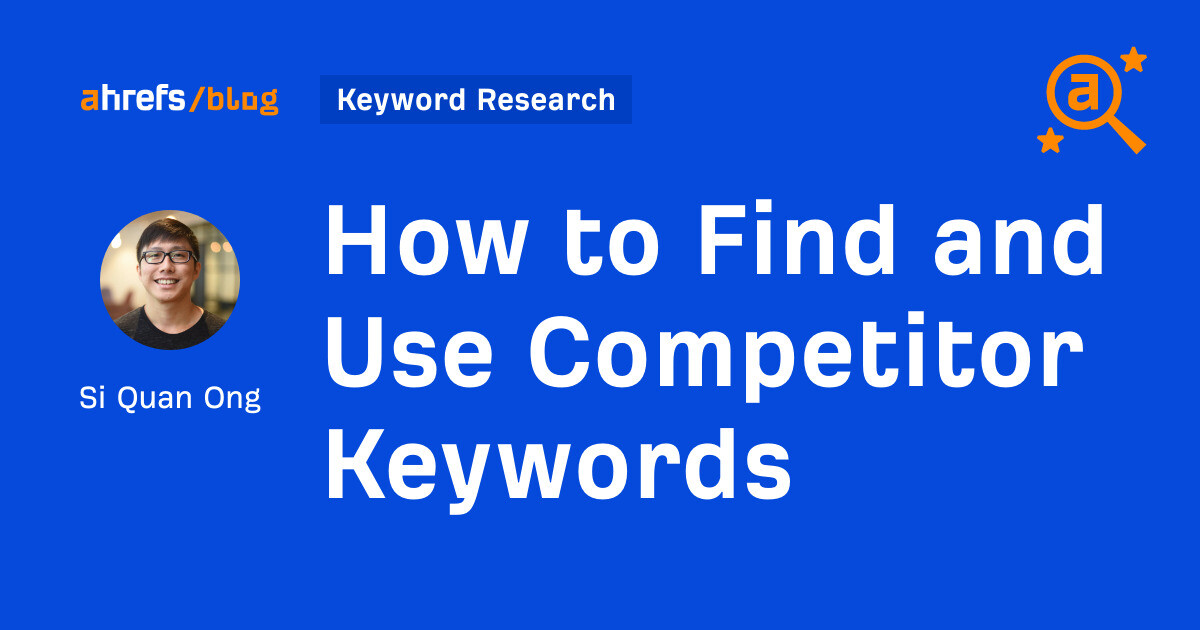
Competitor keywords are the keywords your rivals rank for in Google’s search results. They may rank organically or pay for Google Ads to rank in the paid results.
Knowing your competitors’ keywords is the easiest form of keyword research. If your competitors rank for or target particular keywords, it might be worth it for you to target them, too.
There is no way to see your competitors’ keywords without a tool like Ahrefs, which has a database of keywords and the sites that rank for them. As far as we know, Ahrefs has the biggest database of these keywords.
How to find all the keywords your competitor ranks for
- Go to Ahrefs’ Site Explorer
- Enter your competitor’s domain
- Go to the Organic keywords report
The report is sorted by traffic to show you the keywords sending your competitor the most visits. For example, Mailchimp gets most of its organic traffic from the keyword “mailchimp.”


Since you’re unlikely to rank for your competitor’s brand, you might want to exclude branded keywords from the report. You can do this by adding a Keyword > Doesn’t contain filter. In this example, we’ll filter out keywords containing “mailchimp” or any potential misspellings:
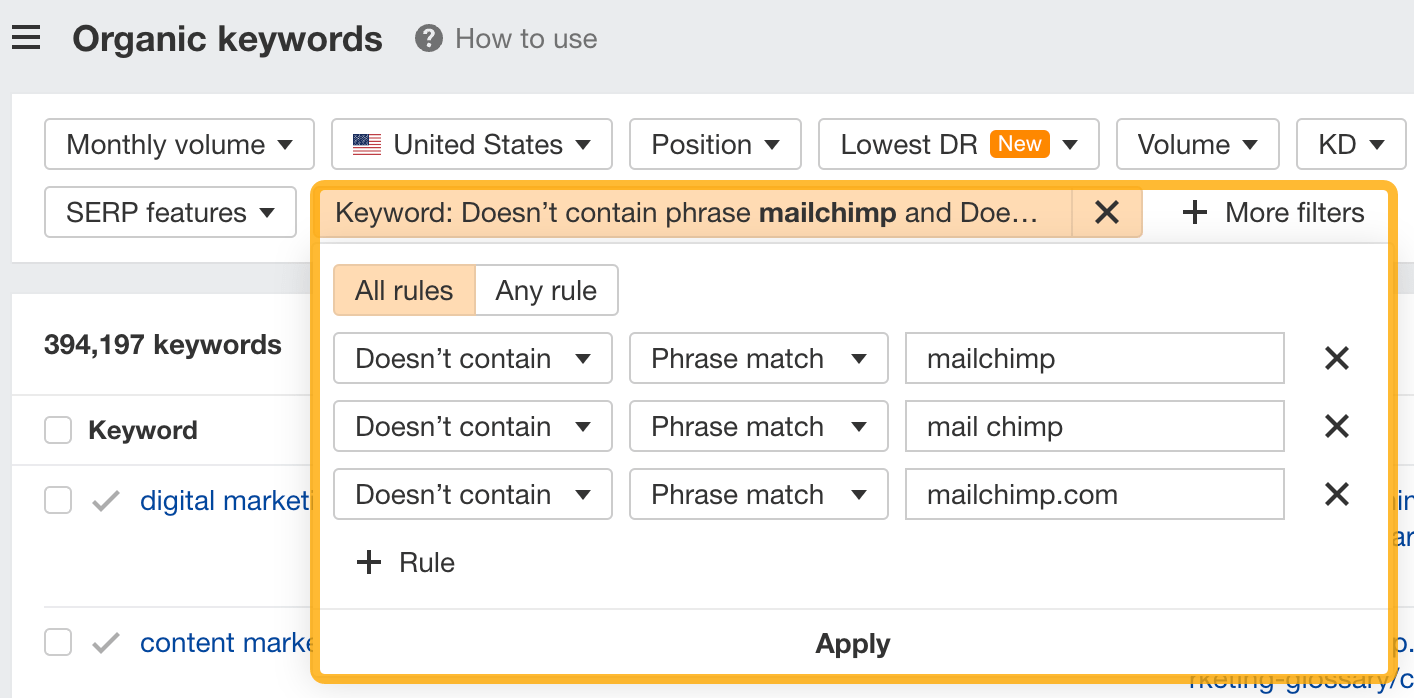

If you’re a new brand competing with one that’s established, you might also want to look for popular low-difficulty keywords. You can do this by setting the Volume filter to a minimum of 500 and the KD filter to a maximum of 10.
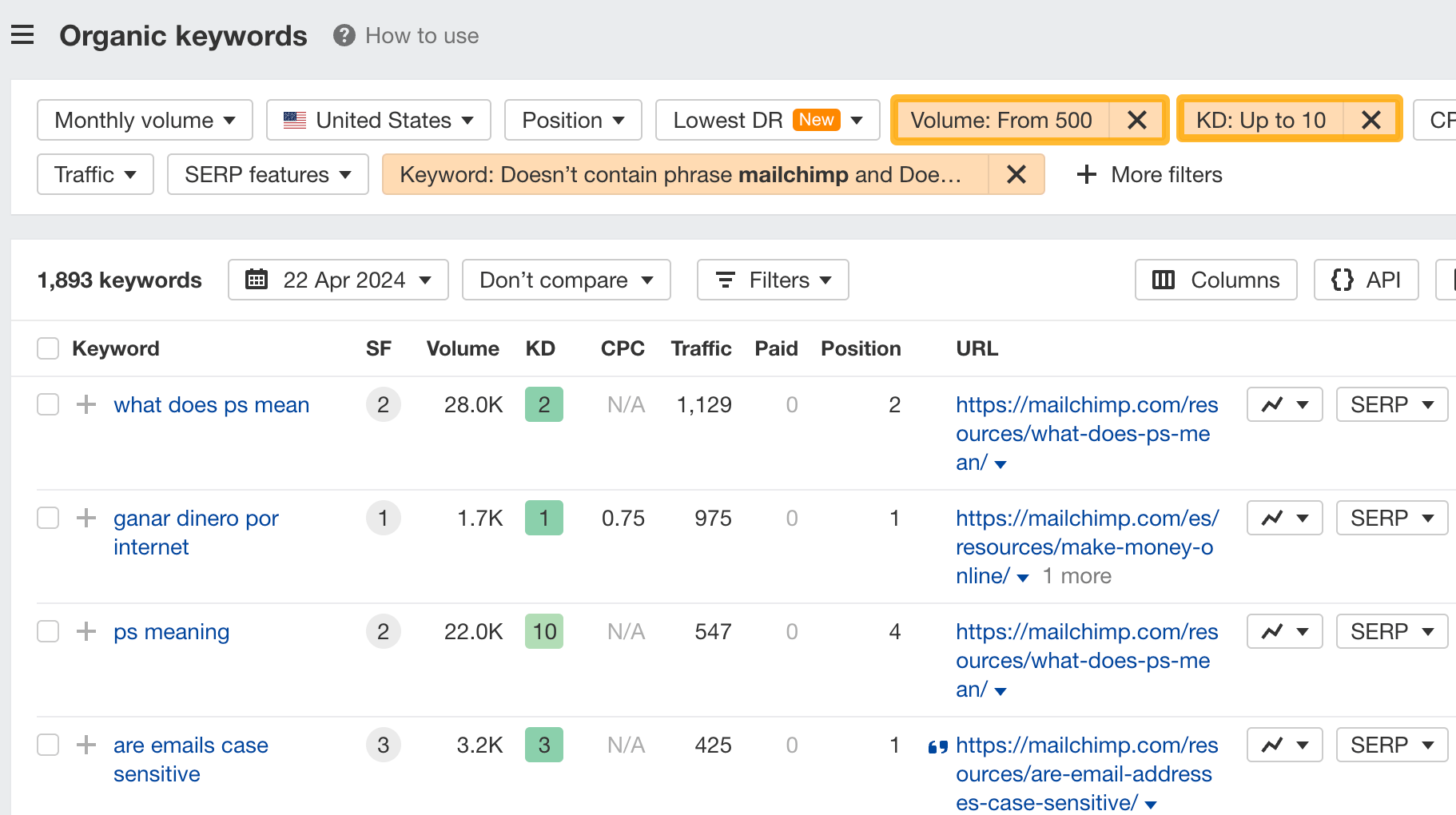

How to find keywords your competitor ranks for, but you don’t
- Go to Competitive Analysis
- Enter your domain in the This target doesn’t rank for section
- Enter your competitor’s domain in the But these competitors do section
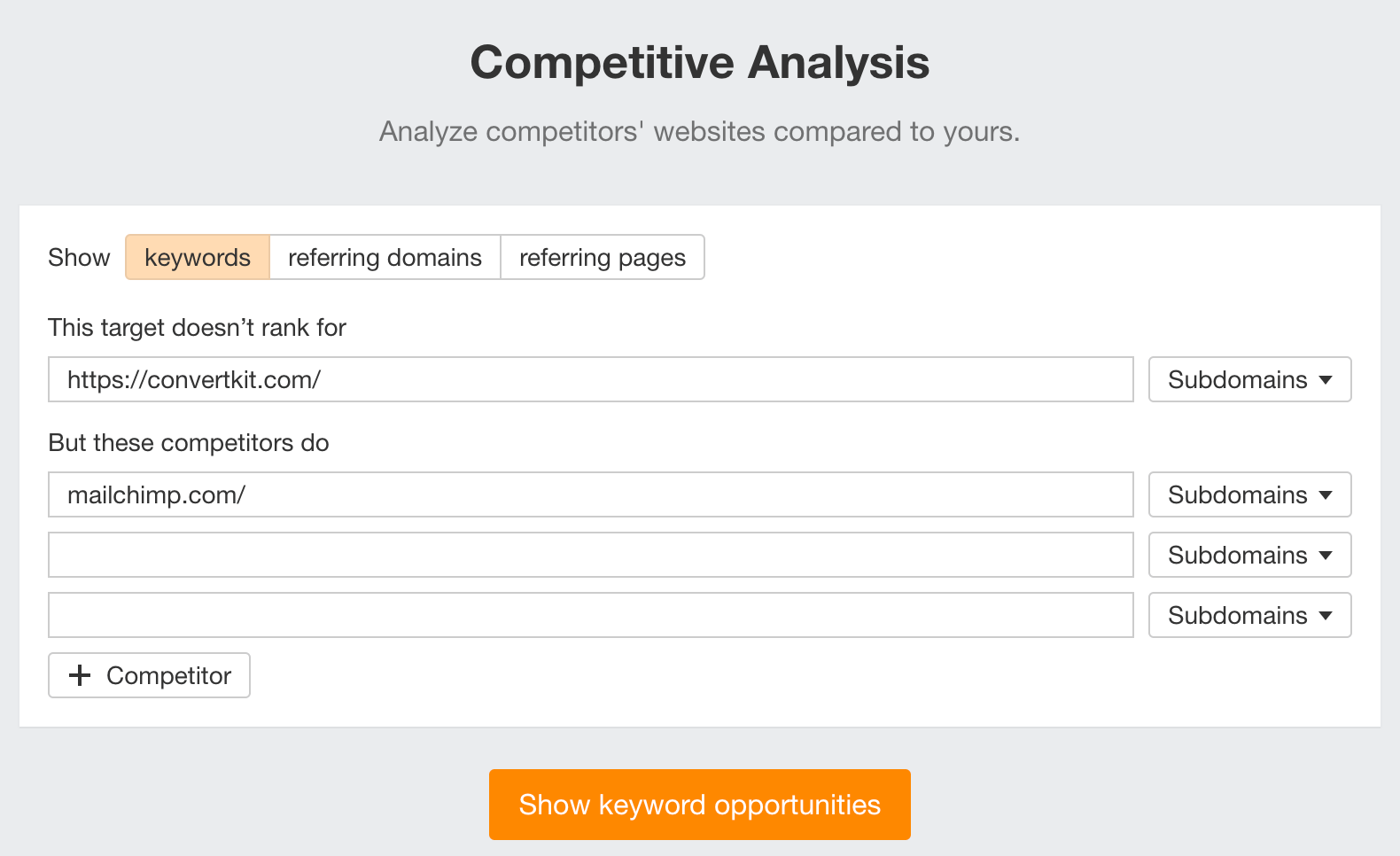

Hit “Show keyword opportunities,” and you’ll see all the keywords your competitor ranks for, but you don’t.
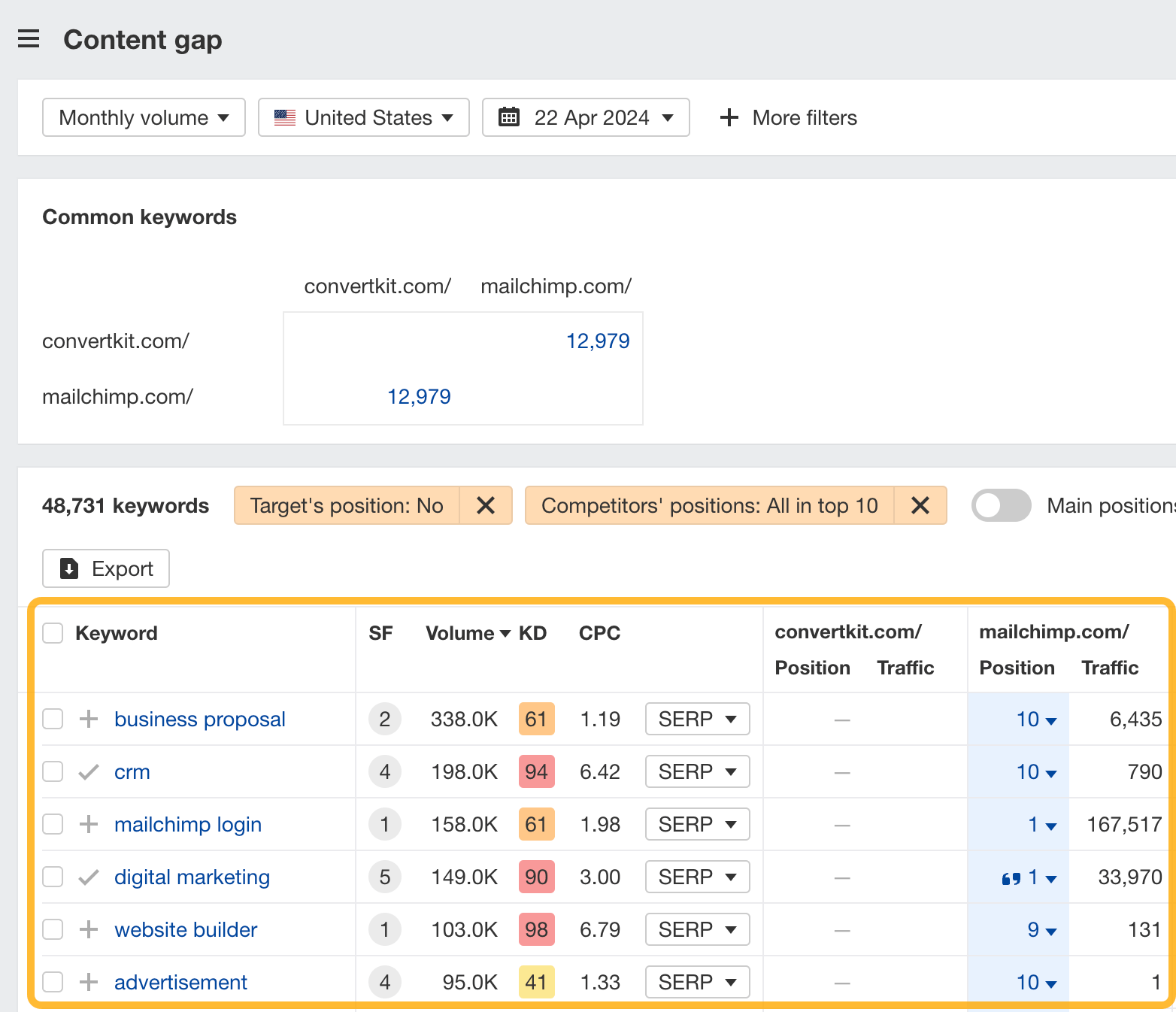

You can also add a Volume and KD filter to find popular, low-difficulty keywords in this report.
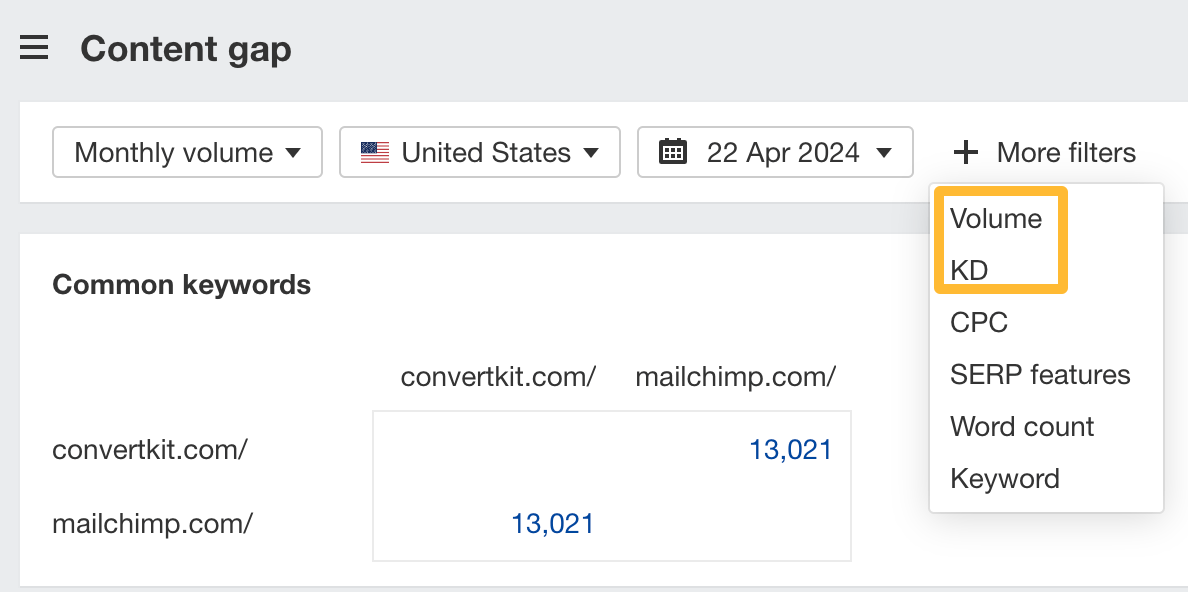

How to find keywords multiple competitors rank for, but you don’t
- Go to Competitive Analysis
- Enter your domain in the This target doesn’t rank for section
- Enter the domains of multiple competitors in the But these competitors do section
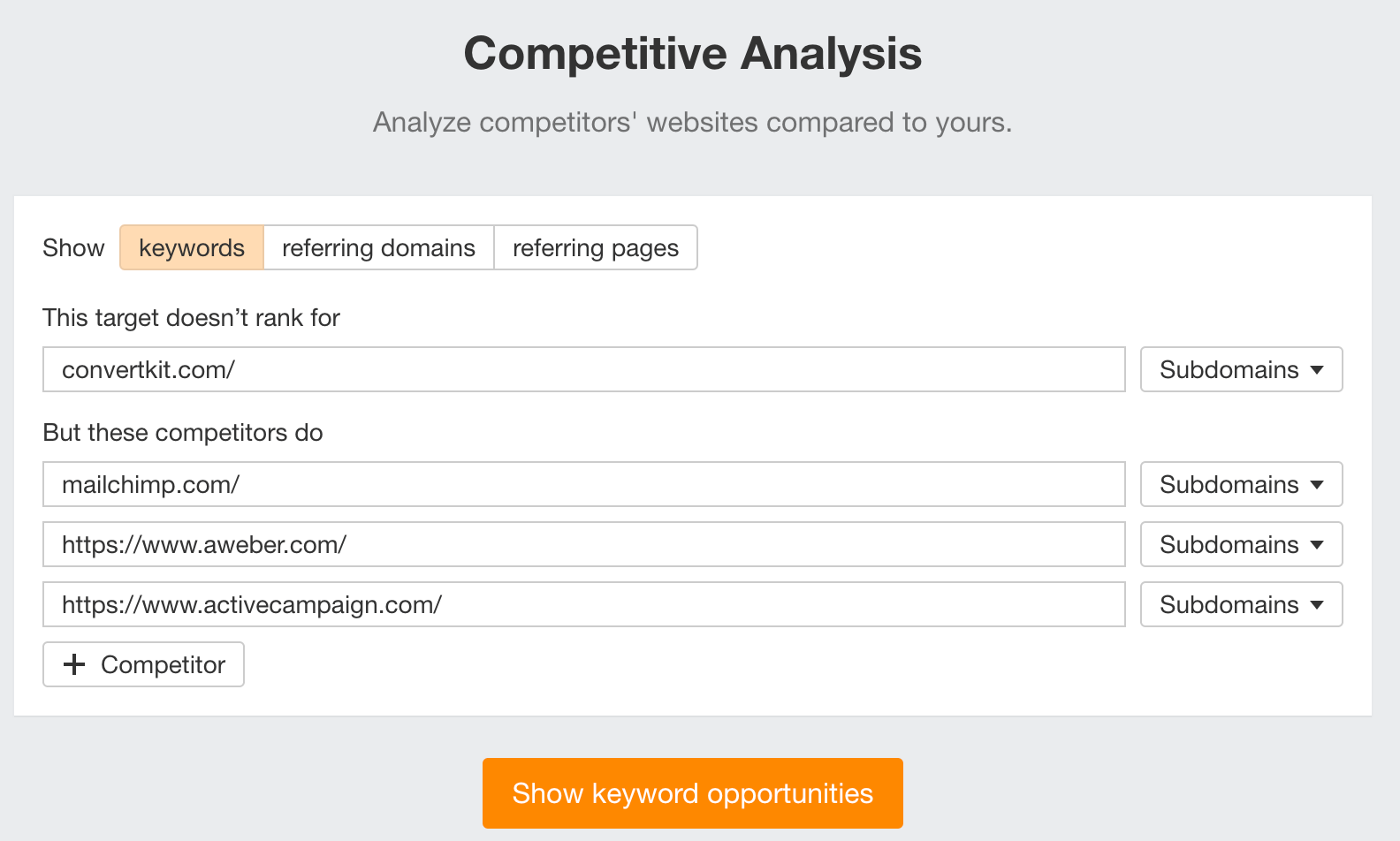

You’ll see all the keywords that at least one of these competitors ranks for, but you don’t.
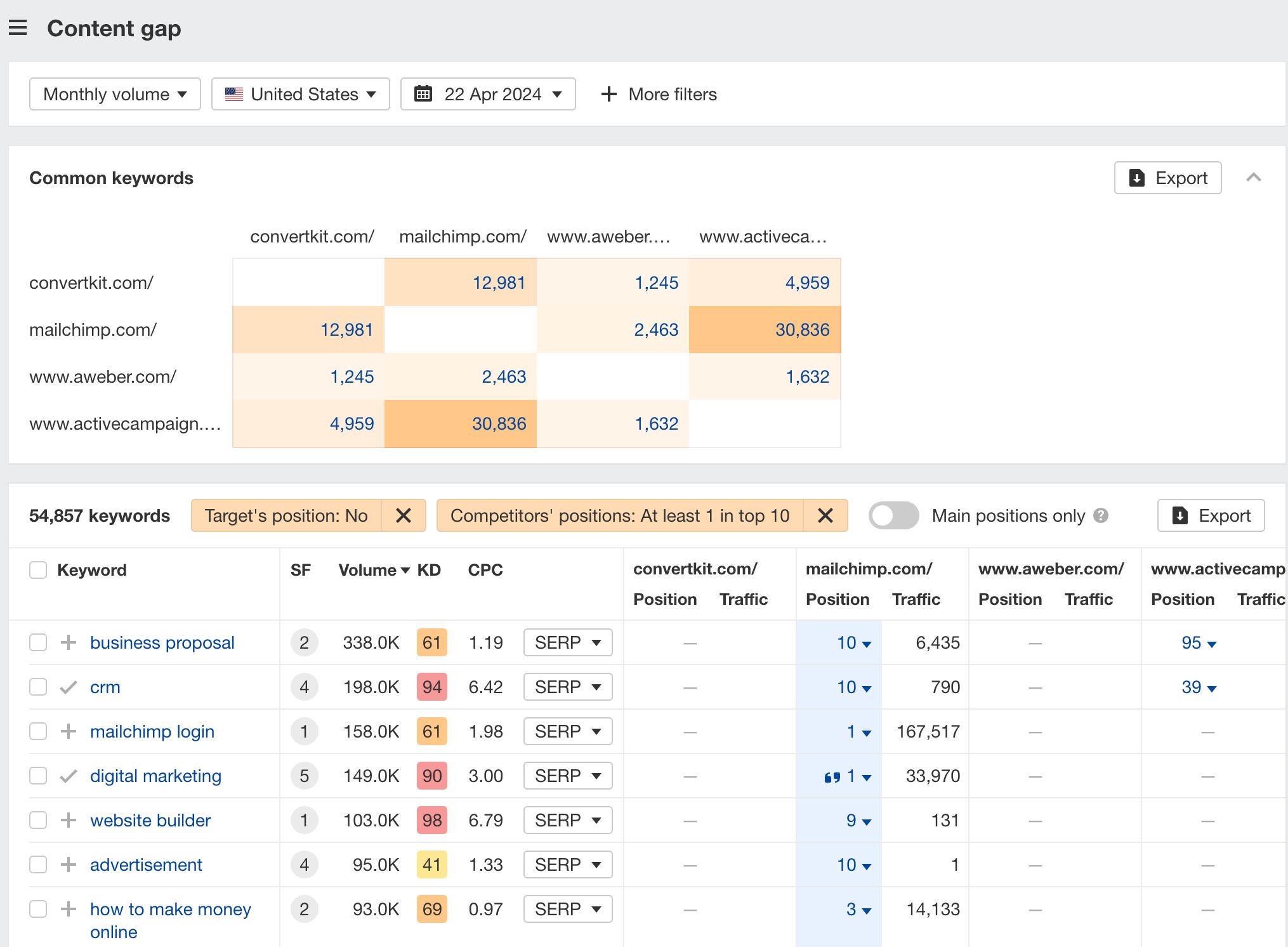

You can also narrow the list down to keywords that all competitors rank for. Click on the Competitors’ positions filter and choose All 3 competitors:
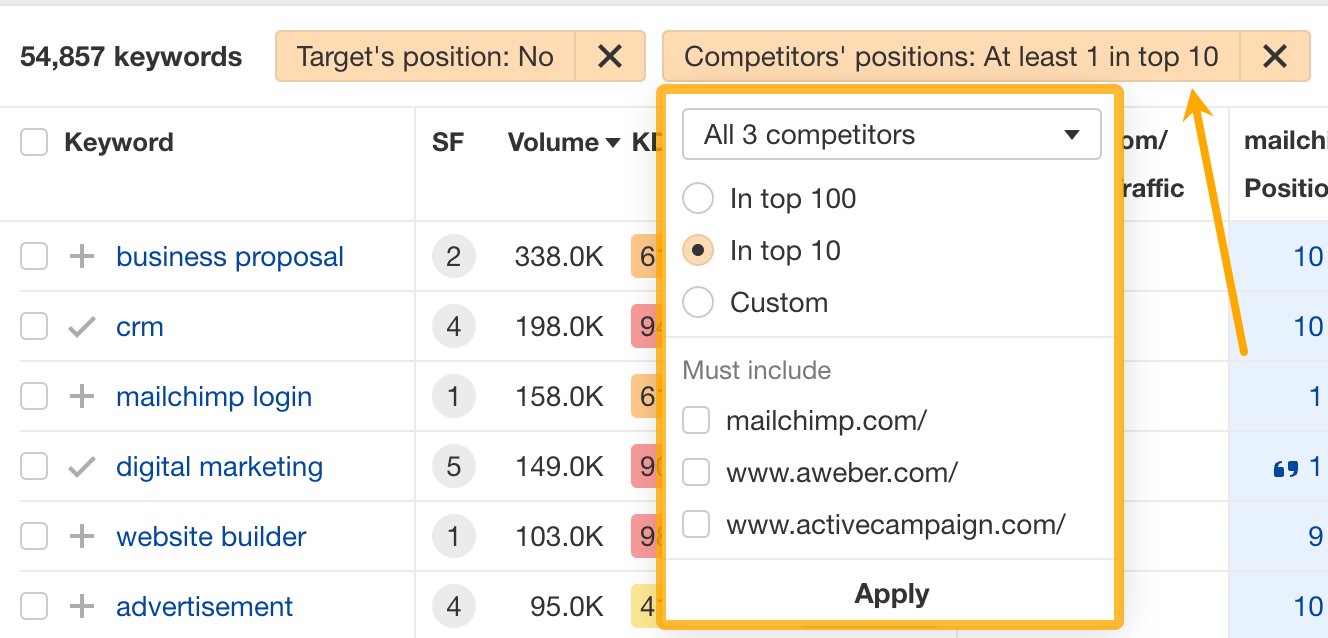

- Go to Ahrefs’ Site Explorer
- Enter your competitor’s domain
- Go to the Paid keywords report
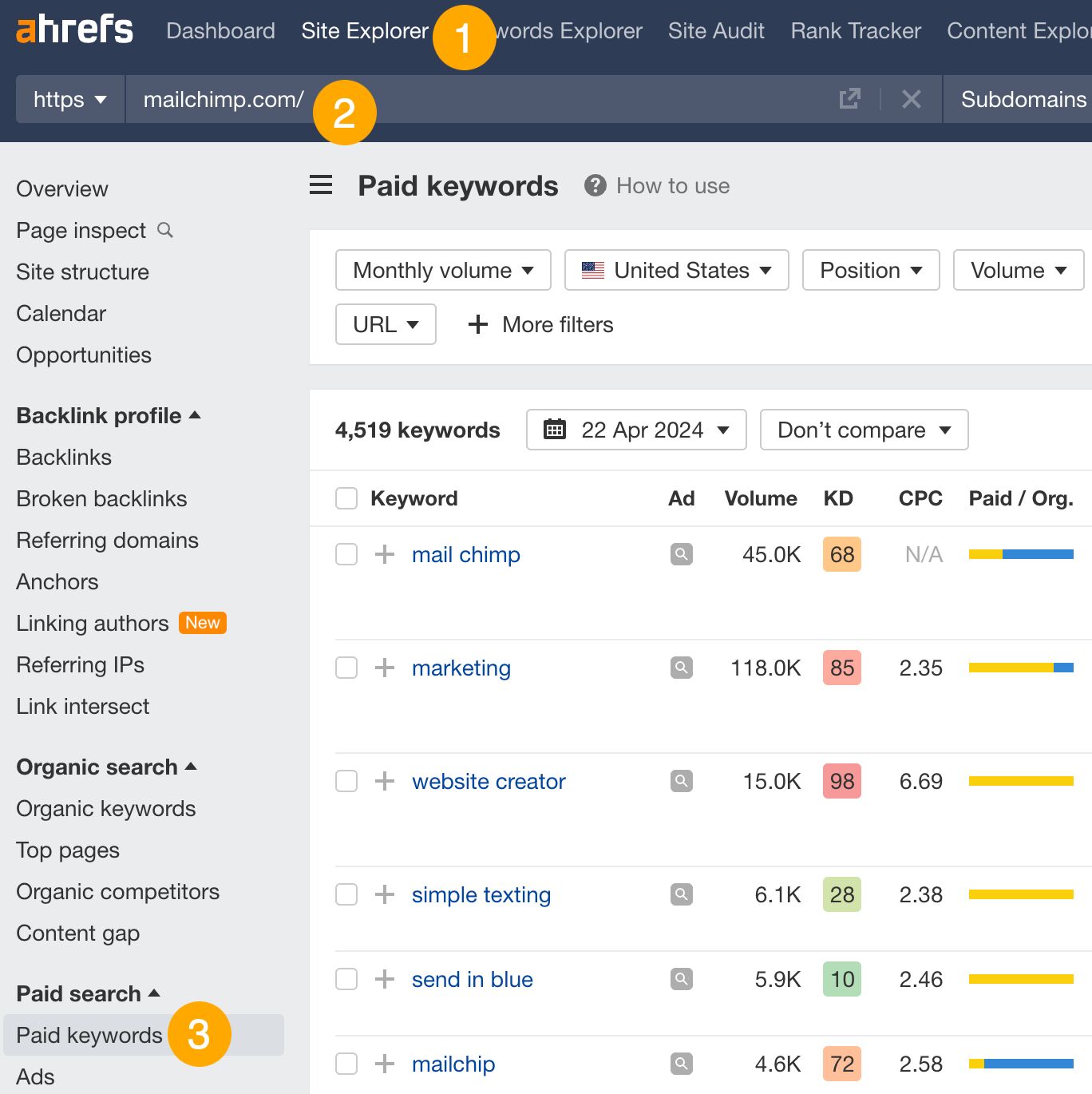

This report shows you the keywords your competitors are targeting via Google Ads.
Since your competitor is paying for traffic from these keywords, it may indicate that they’re profitable for them—and could be for you, too.
You know what keywords your competitors are ranking for or bidding on. But what do you do with them? There are basically three options.
1. Create pages to target these keywords
You can only rank for keywords if you have content about them. So, the most straightforward thing you can do for competitors’ keywords you want to rank for is to create pages to target them.
However, before you do this, it’s worth clustering your competitor’s keywords by Parent Topic. This will group keywords that mean the same or similar things so you can target them all with one page.
Here’s how to do that:
- Export your competitor’s keywords, either from the Organic Keywords or Content Gap report
- Paste them into Keywords Explorer
- Click the “Clusters by Parent Topic” tab
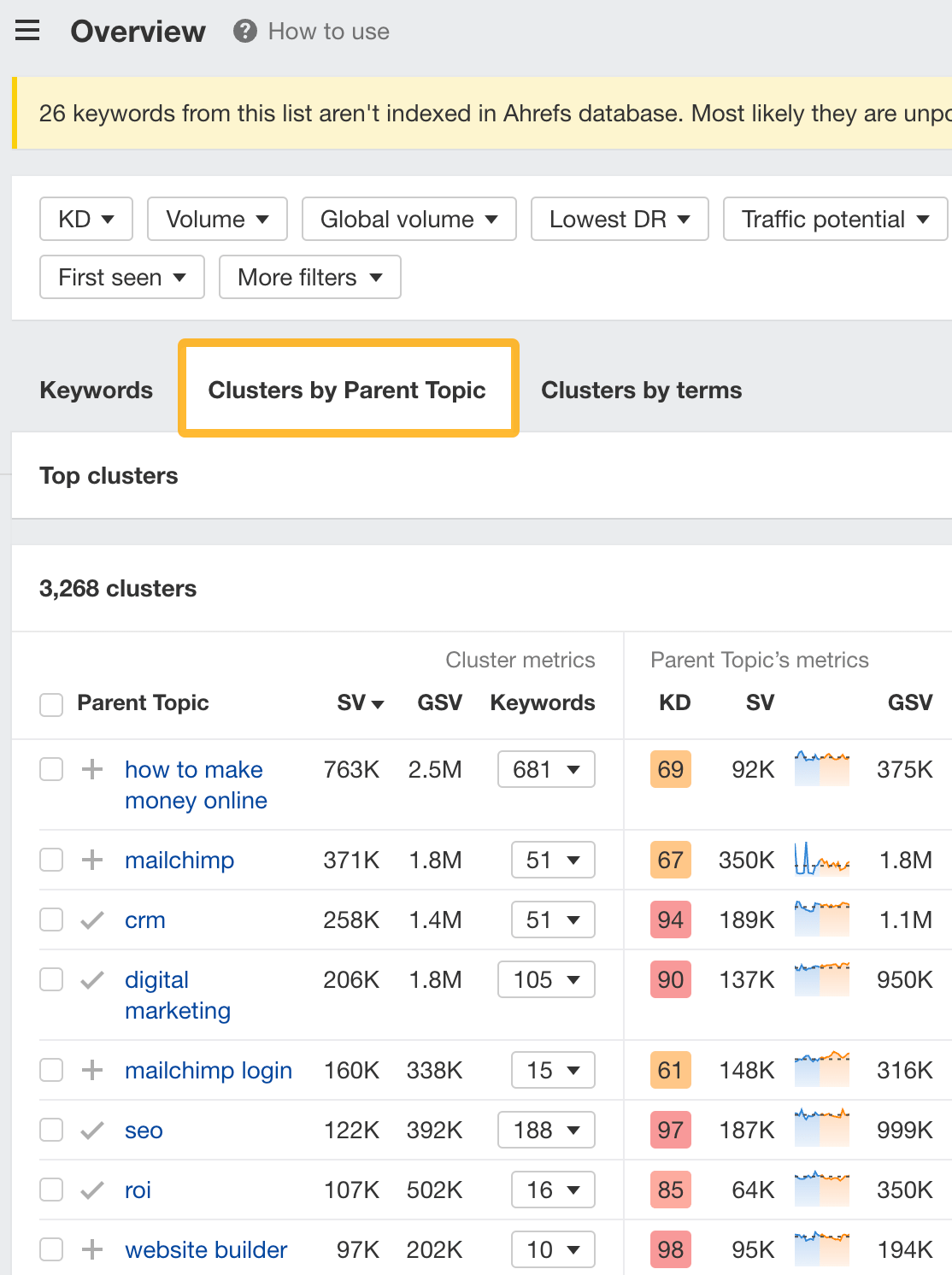

For example, MailChimp ranks for keywords like “what is digital marketing” and “digital marketing definition.” These and many others get clustered under the Parent Topic of “digital marketing” because people searching for them are all looking for the same thing: a definition of digital marketing. You only need to create one page to potentially rank for all these keywords.
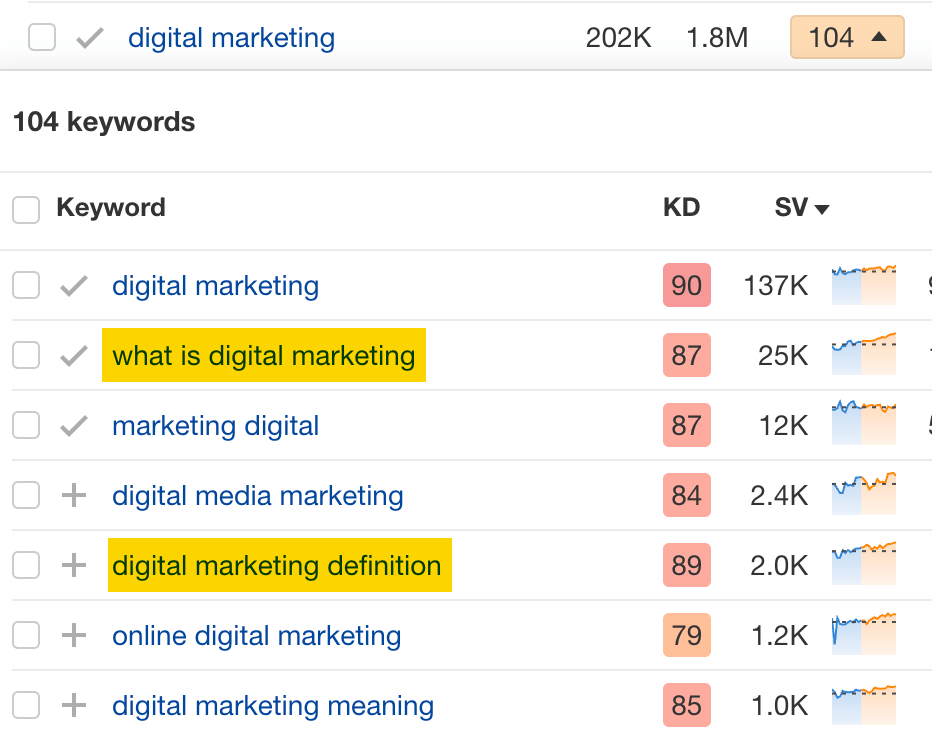

2. Optimize existing content by filling subtopics
You don’t always need to create new content to rank for competitors’ keywords. Sometimes, you can optimize the content you already have to rank for them.
How do you know which keywords you can do this for? Try this:
- Export your competitor’s keywords
- Paste them into Keywords Explorer
- Click the “Clusters by Parent Topic” tab
- Look for Parent Topics you already have content about
For example, if we analyze our competitor, we can see that seven keywords they rank for fall under the Parent Topic of “press release template.”


If we search our site, we see that we already have a page about this topic.


If we click the caret and check the keywords in the cluster, we see keywords like “press release example” and “press release format.”
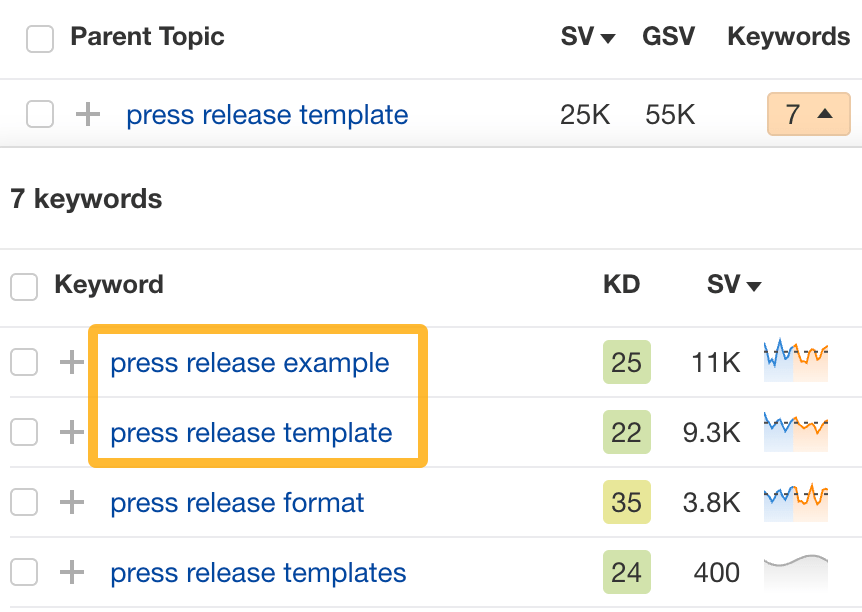

To rank for the keywords in the cluster, we can probably optimize the page we already have by adding sections about the subtopics of “press release examples” and “press release format.”
3. Target these keywords with Google Ads
Paid keywords are the simplest—look through the report and see if there are any relevant keywords you might want to target, too.
For example, Mailchimp is bidding for the keyword “how to create a newsletter.”


If you’re ConvertKit, you may also want to target this keyword since it’s relevant.
If you decide to target the same keyword via Google Ads, you can hover over the magnifying glass to see the ads your competitor is using.
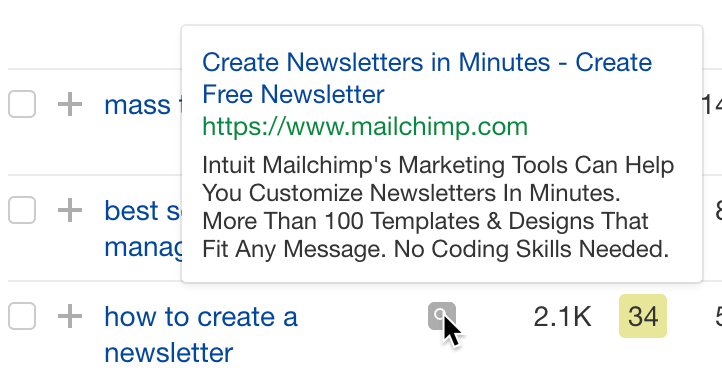

You can also see the landing page your competitor directs ad traffic to under the URL column.


Learn more
Check out more tutorials on how to do competitor keyword analysis:
SEO
Google Confirms Links Are Not That Important

Google’s Gary Illyes confirmed at a recent search marketing conference that Google needs very few links, adding to the growing body of evidence that publishers need to focus on other factors. Gary tweeted confirmation that he indeed say those words.
Background Of Links For Ranking
Links were discovered in the late 1990’s to be a good signal for search engines to use for validating how authoritative a website is and then Google discovered soon after that anchor text could be used to provide semantic signals about what a webpage was about.
One of the most important research papers was Authoritative Sources in a Hyperlinked Environment by Jon M. Kleinberg, published around 1998 (link to research paper at the end of the article). The main discovery of this research paper is that there is too many web pages and there was no objective way to filter search results for quality in order to rank web pages for a subjective idea of relevance.
The author of the research paper discovered that links could be used as an objective filter for authoritativeness.
Kleinberg wrote:
“To provide effective search methods under these conditions, one needs a way to filter, from among a huge collection of relevant pages, a small set of the most “authoritative” or ‘definitive’ ones.”
This is the most influential research paper on links because it kick-started more research on ways to use links beyond as an authority metric but as a subjective metric for relevance.
Objective is something factual. Subjective is something that’s closer to an opinion. The founders of Google discovered how to use the subjective opinions of the Internet as a relevance metric for what to rank in the search results.
What Larry Page and Sergey Brin discovered and shared in their research paper (The Anatomy of a Large-Scale Hypertextual Web Search Engine – link at end of this article) was that it was possible to harness the power of anchor text to determine the subjective opinion of relevance from actual humans. It was essentially crowdsourcing the opinions of millions of website expressed through the link structure between each webpage.
What Did Gary Illyes Say About Links In 2024?
At a recent search conference in Bulgaria, Google’s Gary Illyes made a comment about how Google doesn’t really need that many links and how Google has made links less important.
Patrick Stox tweeted about what he heard at the search conference:
” ‘We need very few links to rank pages… Over the years we’ve made links less important.’ @methode #serpconf2024″
Google’s Gary Illyes tweeted a confirmation of that statement:
“I shouldn’t have said that… I definitely shouldn’t have said that”
Why Links Matter Less
The initial state of anchor text when Google first used links for ranking purposes was absolutely non-spammy, which is why it was so useful. Hyperlinks were primarily used as a way to send traffic from one website to another website.
But by 2004 or 2005 Google was using statistical analysis to detect manipulated links, then around 2004 “powered-by” links in website footers stopped passing anchor text value, and by 2006 links close to the words “advertising” stopped passing link value, links from directories stopped passing ranking value and by 2012 Google deployed a massive link algorithm called Penguin that destroyed the rankings of likely millions of websites, many of which were using guest posting.
The link signal eventually became so bad that Google decided in 2019 to selectively use nofollow links for ranking purposes. Google’s Gary Illyes confirmed that the change to nofollow was made because of the link signal.
Google Explicitly Confirms That Links Matter Less
In 2023 Google’s Gary Illyes shared at a PubCon Austin that links were not even in the top 3 of ranking factors. Then in March 2024, coinciding with the March 2024 Core Algorithm Update, Google updated their spam policies documentation to downplay the importance of links for ranking purposes.
The documentation previously said:
“Google uses links as an important factor in determining the relevancy of web pages.”
The update to the documentation that mentioned links was updated to remove the word important.
Links are not just listed as just another factor:
“Google uses links as a factor in determining the relevancy of web pages.”
At the beginning of April Google’s John Mueller advised that there are more useful SEO activities to engage on than links.
Mueller explained:
“There are more important things for websites nowadays, and over-focusing on links will often result in you wasting your time doing things that don’t make your website better overall”
Finally, Gary Illyes explicitly said that Google needs very few links to rank webpages and confirmed it.
I shouldn’t have said that… I definitely shouldn’t have said that
— Gary 鯨理/경리 Illyes (so official, trust me) (@methode) April 19, 2024
Why Google Doesn’t Need Links
The reason why Google doesn’t need many links is likely because of the extent of AI and natural language undertanding that Google uses in their algorithms. Google must be highly confident in its algorithm to be able to explicitly say that they don’t need it.
Way back when Google implemented the nofollow into the algorithm there were many link builders who sold comment spam links who continued to lie that comment spam still worked. As someone who started link building at the very beginning of modern SEO (I was the moderator of the link building forum at the #1 SEO forum of that time), I can say with confidence that links have stopped playing much of a role in rankings beginning several years ago, which is why I stopped about five or six years ago.
Read the research papers
Authoritative Sources in a Hyperlinked Environment – Jon M. Kleinberg (PDF)
The Anatomy of a Large-Scale Hypertextual Web Search Engine
Featured Image by Shutterstock/RYO Alexandre
-

 PPC4 days ago
PPC4 days ago19 Best SEO Tools in 2024 (For Every Use Case)
-

 MARKETING7 days ago
MARKETING7 days agoWill Google Buy HubSpot? | Content Marketing Institute
-
SEARCHENGINES7 days ago
Daily Search Forum Recap: April 16, 2024
-

 SEO7 days ago
SEO7 days agoGoogle Clarifies Vacation Rental Structured Data
-

 MARKETING6 days ago
MARKETING6 days agoStreamlining Processes for Increased Efficiency and Results
-
SEARCHENGINES6 days ago
Daily Search Forum Recap: April 17, 2024
-

 SEO6 days ago
SEO6 days agoAn In-Depth Guide And Best Practices For Mobile SEO
-

 PPC6 days ago
PPC6 days ago97 Marvelous May Content Ideas for Blog Posts, Videos, & More





You must be logged in to post a comment Login